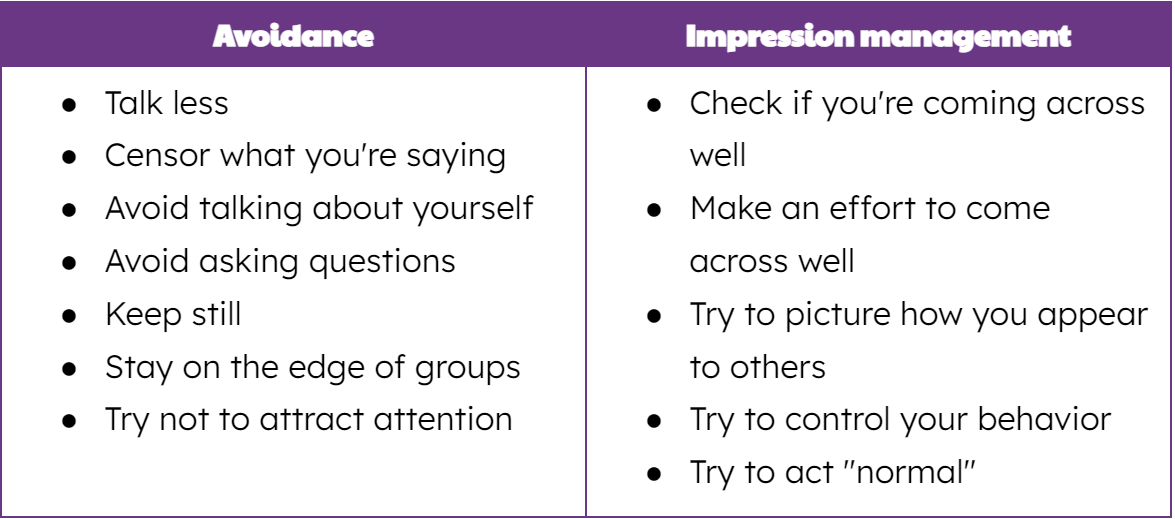Disclaimer: My content is NOT a substitute for professional advice, diagnosis, or treatment. When in doubt, ask a therapist!
Safety behaviors.
They can often be invisible.
But once you spot them, you will see them across your conversations… (especially if you’re socially anxious like me)
What are safety behaviors?
Safety behaviors are what you do or don’t do to reduce your anxiety and prevent your social fears from coming true.
According to Larry A. Cohen, the co-founder of the National Social Anxiety Center, they are the #1 challenge to making progress, whether it’s on your own or in therapy.
How safety behaviors maintain and even worsen anxiety
Safety behaviors aren’t bad or wrong per se — they are actually understandable, normal responses to protect yourself from any perceived danger.
In fact, safety behaviors can be helpful. For example, if you were worried about presenting tomorrow, preparing your slides and rehearsing in front of a friend would help you feel more ready.
But when you’re using safety behaviors to avoid anxiety, that’s where the trouble starts…
Research shows that safety behaviors maintain and increase social anxiety. Larry explained:
“They prevent us from learning that our hot thoughts and beliefs are distorted, so we don’t lessen anxiety or build self-confidence. Even when it goes well, our confidence is in the safety-seeking behaviors, not in ourselves.
So, what do safety behaviors look like? Here’s a non-exhaustive list of them:
Examples of safety behaviors
According to David M. Clark, an Oxford University psychologist, there are two kinds of safety behaviors: avoidance and impression management.
- Avoidance: Minimizing your presence in social situations. For example, avoiding eye contact.
- Impression management: Projecting an attractive image by strictly monitoring and controlling your actions. For example, choosing your words very carefully all the time.

A new type of safety behavior — very much related to impression management — is anxiety-symptom control, which includes attempts to hide physical symptoms that are caused by anxiety.
For instance, holding a cup tightly to stop your hands from trembling, or blanking out in conversation (here’s what to do when the latter happens).
Among the three safety behavior types, avoidance-related safety behaviors are more likely to lead to a negative impression. Why?
Imagine that you were talking with someone who gave a stream of one-word answers. How would you feel about them? You would probably think, “Hmm, this person isn’t interested in talking… maybe he doesn’t like me!”
How to know if you’re engaging in safety behavior
It can be hard to define what is safety behavior and what isn’t. And more importantly, it’s the function of the behavior that matters. Here are two questions I’d ask:
- Presence or distraction: Does this behavior help me stay present during the conversation? Or does it distract me away from my anxiety?
- Approach or avoid: Does this behavior help me approach or avoid my anxiety? (Credit: Teresa Lewis, M.Couns.)
How to reduce safety behaviors
When addressing safety behaviors, it’s important to be realistic.
If you’re used to walking around with sandbags on your feet, taking off all the weight will probably freak you out!
Take the following steps to be more aware of your safety behaviors, so that you can move towards reducing them:
- List down all your safety behaviors in social situations. If you are unsure, notice what you tend to do when you feel anxious, or ask a family member/friend for feedback.
- Decide which ones you can try doing less of — ones that don’t feel too hard to stop doing — and pick one to focus on.
- Gradually reduce the chosen safety behavior(s): For starters, don’t engage in the safety behavior for 10 seconds, then slowly increase the interval until you are comfortable not using the safety behavior at all.
- Practice mindfulness: As you drop the safety behavior, you will naturally feel more anxiety (since you’re not avoiding it!) Stay aware and compassionate of whatever you’re feeling and sensing in your body. Here’s a list of mindfulness techniques.
- Turn this into an experiment. For the next few conversations, reduce your safety behavior and see what happens. During the conversation, practice mindfulness, which helps you become aware when you engage in any of the behaviors.
(Here’s how to design a behavioral experiment.)
Related articles
- Avoidance: how it makes social anxiety worse
- Cognitive behavior therapy (CBT) for social anxiety
- Acceptance and Commitment Therapy (ACT) for social anxiety
- Does mindfulness help social anxiety? Yes (here’s how)
- What’s the best meditation for social anxiety?
- How to deal with social anxiety in the moment

